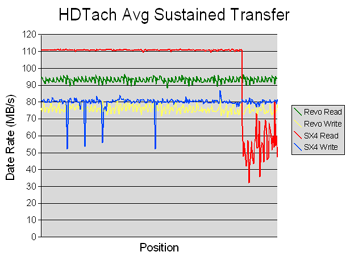HDTach Results and Final Thoughts
Will HDTach's sustained throughput benchmarks correlate with those obtained with IOMeter?
The answer: For the most part yes. However, HDTach performs a transfer test in blocks spanning the entire array. In the above graph the Revo 64, while slower, provides a more consistent transfer rate across the array. Curiously, the SX4 seems to run into some trouble towards the end of the run. I re-ran the test to verify it wasn't a anomaly such as some other device hogging the PCI bus; the same results were presented to me again. When reaching the edges of a disk, some tail-off in read speeds can occur, but here we are seeing a sudden drop-off, so that doesn't explain this result.
Put the arrays in a critical state and the Revo 64 yields almost identical results to when its array is healthy. If it wasn't for the management software informing you of a failure, you'd not actually notice a problem! The same rings true for the SX4 until we get to the 'trouble zone' where throughput drops further. These results are a little bit worrying. I was able to replicate them with another set of slower hard disks (four Seagate Barracudas) so the issue appears controller/driver related rather than disk related.
Try before you buy
If the thought of a RAID 3 PCI add-in card has you intrigued, but not quite sold on the idea, then businesses can try an XFX Revo 64 card before buying one.
Scan have created a try before you buy scheme, whereby you can request a loan of one of these cards to see if it will meet your needs. If you've not used RAID before, then this could be your chance to try it out with minimal costs and if you already have existing RAID configurations then Scan have, through this initiative, given you an opportunity to compare the new Revo 64 card with your existing equipment.
Final Thoughts
With more and more people adopting RAID, the choice of add-in cards becomes more important. Onboard RAID 0, 1 or 1+0/0+1 solutions are not ideal RAID solutions either due to their lack of redundancy, or the amount of disk space lost to redundancy. With that in mind, somebody serious about RAID and thinking realistically is going to be looking for an add-in card.
The look we've had at the Promise FastTrack S150 SX4 and XFX Revo 64 has demonstrated both how easy creating & looking after a parity powered RAID array can be and the smile inducing data throughput that can be obtained. We've also seen just how big a difference a dedicated RAID processor can have on CPU loads. Thanks to the glory of SATA, arrays can be damaged and rebuilt without even restarting the system. That's zero downtime, folks.
On the subject of the Revo 64's driverless nature. This will prove a godsend for many, simplifying the OS installation process and also making migration onto a Revo 64 based RAID architecture without any driver installation hassle. It's hard to put a value on a feature like this; after so long you take it for granted, but if you've ever had driver hassle with a RAID array, you'll appreciate the freedom the Revo 64 brings.
Despite the higher read throughput of the SX4 (arguably down to the different RAID configuration than the card's capabilities) and better response times under simulated workstation loads, the Revo 64 proves to be more consistent. This card can pump out in excess of 90MB/s even with a failed disk and your CPU will hardly flutter. Gamers can enjoy fast load times and no hit on their FPS during disk access, audiophiles can keep their media flowing through a disk crash and office users have a RAID solution that's a doddle to migrate to and manage. Whichever scenario you put the Revo 64 into, it can do the job and do it well.
If I'm allowed to have a gripe with this card, it is that a PCIe solution isn't available yet. Few motherboards have 66MHz PCI slots, but PCIe is rapidly being adopted. Comparing the PCI limited benchmarks of the two add-in cards against the freedom experienced by the NVIDIA onboard SATA RAID solution gives us an idea of just how wonderful a PCIe RAID card could be. Don't let that taint your opinion of the card, though. Throughput is impressive regardless of bus limitations.
If you need high data rates and really don't need the hassle of downtime thanks to a dead hard drive, RAID is your answer. If you want efficient usage of disk space, you're going to need an add-in card for a decent solution. If you want to combine all that with low CPU usage and ease of use, then the XFX Revo 64 is the card for you. Wait a few months if you can, though, and then enjoy the fruits of PCIe, which we'll hopefully be able to examine for you too.
HEXUS Awards
Across the board this card works well. Recommended for executive, gaming and media uses.



HEXUS Right2Reply
Netcell responded to our article with the following insight into the CPU usage figures obtained for the Revo 64.
The CPU utilization for our part is only 2% or less. Hexus’ chart is showing 10% - 13% because the I/O Meter and other applications take up at least 10% of the CPU utilization running their programs. the best way to show our CPU utilization at very low levels is to actually do a re-build or Migration and then do a measurement.
Cheers,
Oliver,
NetCell Corporation.















